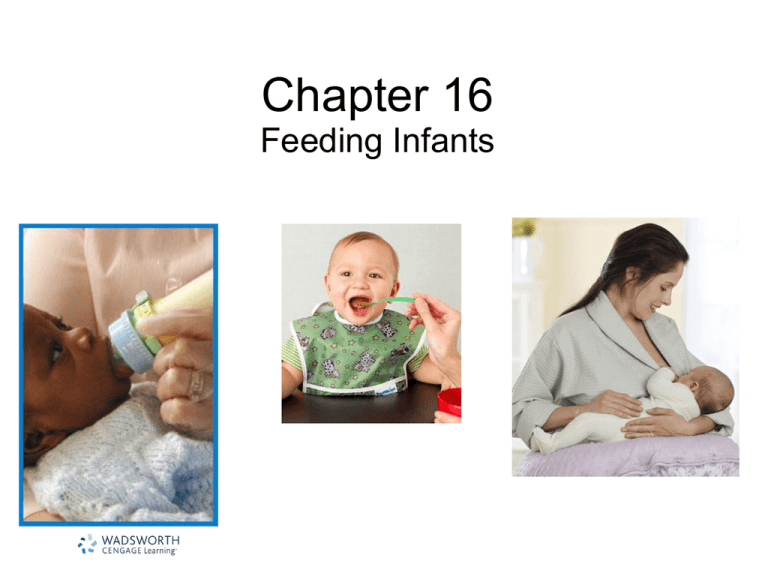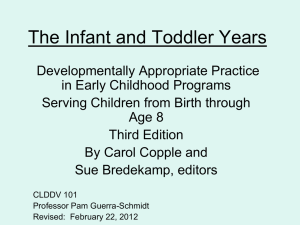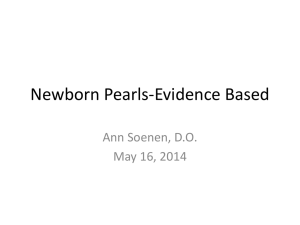
Chapter 16
Feeding Infants
Infant Growth Patterns
• Infants experience rapid growth during the
first year:
– Gains approximately 2/3 ounce/day between
birth and 6 months; gains of 1/2 ounce/day
between 6 and 12 months are typical.
– Length increases by approximately 10 inches.
– Basal metabolic rate (BMR) is higher than an
adults’.
Low Birth Weight Infants
• The data on low birth
weights is worrisome
because such babies
— those born at less
than 5.5 pounds —
are at greater risk of
dying in infancy or
experiencing longterm disabilities.
Determinants of Infants’ Nutrient
Needs
• Rapid growth
• Small stomach capacity
• Physiological and developmental
readiness
©2012 Cengage Learning.
All Rights Reserved.
Determinants of Infants’ Nutrient
Needs (continued)
• Rapid growth
– Infants require approximately 45 to 55
calories per pound/body weight during the first
six months; 40 to 50 calories/pound are
needed during the second six months
• Small stomach capacity
– Infants are able to consume only limited
amounts at each feeding so they must eat
often
©2012 Cengage Learning.
All Rights Reserved.
Determinants of Infants’ Nutrient
Needs (continued)
• Physiological and developmental readiness:
– Intestines—are not fully functional; they do not
produce the enzyme amylase, which is needed
for digesting starches (i.e., cereals).
– Kidneys—are not effective in filtering waste
products, thus making infants more prone to
dehydration.
– Tongue—reflexes allow infant to suck but not to
move food from front to back of mouth.
©2012 Cengage Learning.
All Rights Reserved.
Feeding Infants
• Breast milk or formula provide all the nutrients
an infant needs for optimal growth and
development during the first four to six months
with the exception of vitamin D.
– The American Academy of Pediatrics recommends a
daily supplement of 400 IU of vitamin D for breast fed
infants. Formula-fed infants do not require this
because formulas contain vitamin D
• Semisolid (pureed) foods should not be
introduced before this time.
©2012 Cengage Learning.
All Rights Reserved.
Breast-Feeding
• Advantages (for infant):
– Provides the right mix of protein,
carbohydrates, and fats in forms that are easy
to digest
– Is high in calories to meet the infant’s growth
and energy needs
– Is especially high in calcium, phosphorus,
iron, and vitamin C
– Provides friendly bacteria that help the infant’s
intestines to develop
©2012 Cengage Learning.
All Rights Reserved.
Breast-Feeding (continued)
• Advantages (for infant) (continued):
– Provides the infant with temporary protection
(antibodies) against many viral and bacterial
illnesses
– Less likely to cause an allergic response
– Volume is produced in response to the
infant’s needs
– Always ready on demand
– Breast-fed infants have been shown to have
lower rates of obesity
©2012 Cengage Learning.
All Rights Reserved.
Breast-Feeding (continued)
• Advantages (for mother):
– A convenience food—no mixing, correct
temperature, no dishes to wash
– Less expensive—no formula to purchase;
however, mothers must increase their dietary
intake of certain nutrients
– Sanitary conditions—always clean; less
chance for introduction of harmful bacteria
– Helps to return the reproductive system back
to normal
©2012 Cengage Learning.
All Rights Reserved.
Breast-Feeding (continued)
• Disadvantages (for mother):
– Must be available
– May limit father’s involvement in the feeding
process
– Mother must pay attention to the quality of her
diet
– Requires family support and freedom from
anxiety
– May not be advisable if mother is ill or taking
certain medications
©2012 Cengage Learning.
All Rights Reserved.
Formula Feeding
• Commercial formulas are similar in composition
to breast milk, but do not contain protective
antibodies.
• Manufacturers have recently added two
essential fatty acids (DHA and ARA) previously
missing from U.S. formulas.
• Mixing with bottled water is recommended to
avoid introducing environmental contaminants.
©2012 Cengage Learning.
All Rights Reserved.
Breast Milk versus Formula
• Both methods adequately meet an infant’s
nutrient needs and provide an opportunity for
bonding.
• Mothers may choose not to nurse or to use a
combination of breast- and formula feeding
based on a variety of factors, including:
– Illness or mother’s need to take certain medications
– Mother needs to be away from the infant periods of
time
– Personal choice
– Mother uses addictive drugs, including tobacco
©2012 Cengage Learning.
All Rights Reserved.
How to Determine an Infant’s
Nutrient Needs
• An infant’s nutrient needs are based on:
– Growth (height, weight) that continues at an
appropriate rate
– Energy for active play
– Absence of frequent illness
©2012 Cengage Learning.
All Rights Reserved.
Introduction of Solid Foods—Knowing
When an Infant Is Ready for Solid Food
• Is able to accept foods
and swallow
• Is able to sit up in a chair
• Is able to assert self
(turns head away,
indicates when no longer
hungry)
• Is ready to interact and
socialize
• Begins to enjoy touching
and picking up foods
©2012 Cengage Learning.
All Rights Reserved.
Introduction of Solid Foods
(continued)
5–6 months
iron-enriched cereals
6–8 months
vegetables, followed by fruits
8–9 months
meat and meat substitutes
Introduction of Solid Foods
(continued)
• Usually foods are introduced in the following
order:
– Cereals—rice being the first because it is less likely to
cause an allergic response
– Vegetables
– Fruits
– Meats and other proteins
• Avoid honey or foods containing honey; they
may contain botulism spores.
• This process may be delayed and take longer
for some children who have special needs.
©2012 Cengage Learning.
All Rights Reserved.
Feeding Cautions
• Choking is common during an infant’s transition
from milk to solid foods. Children with certain
types of special needs may be more prone to
choking.
• Know how to perform the Heimlich maneuver
and CPR.
• Always cut food in small pieces!
• Avoid serving foods that are hard to chew (raw
carrots) or sticky (peanut butter) and difficult to
swallow.
©2012 Cengage Learning.
All Rights Reserved.
Common choke foods for infants
and toddlers include:
•
uncut spaghetti
•
•
•
•
•
•
•
•
•
•
•
•
uncut hot dogs,
peanuts, and
hard or gooey candy
whole grapes
popcorn
nuts
chunks of peanut butter (if your toddler isn't at
risk for food allergies and you decide to give him
peanut butter, spread smooth peanut butter thinly
on bread or a cracker)
chewing gum
raisins
raw vegetables
chunks of meat
chunks of cheese
Case Study
• MissyT. is the mother of 6-week-old Hayden.
• Hayden is Missy's first child.
• Missy's mother lives nearby and is happy to help out with
Hayden's care.
• Missy complains of being tired and mentions to her mother
that Hayden awakens several times during the night and
acts hungry.
• Her mother advises her to add cereal to his bedtime bottle
in order to “fill him up so he will sleep through the night.”
• She also advises cutting larger holes in the nipple so the
cereal won't block the opening.
Case Study
1. Should Missy follow her mother's advice?
2. What are the dangers, if any, of feeding a 6-weekold baby cereal from the bottle?
3. Do child care practices change from generation to
generation?
4. Consider possible short- and long-term
consequences of feeding semi-solid food from a
bottle.
5. How would you respond if you were the teacher
and a parent asked that you feed an infant in this
manner?
Children with Special Needs
• Infants who are born
prematurely
• Have a range of health
problems
• Genetic disorders and
congenital malformations
• Infection
• Medication side effects
and unpleasant medical
treatments
• Swallowing difficulties
• Dental problems
• Conditions that require
surgery
• Special diets
• Fatigue
Bottle Mouth Syndrome
•
•
•
•
•
Can result in such rampant
decay of a child’s teeth that the
child will suffer pain and may
lose teeth at a very early stage.
Acidic liquids damage the
enamel physically.
Liquids high in sugar content
(including milk) encourage
bacterial growth in the mouth.
Carbonated cold drinks and
pure fruit juice are both of these
and should be avoided in
bottles.
Try to use only water in the
bottle if your baby insists on
lying down with one.
Do not to allow a baby to
sleep with a bottle.
Bottle Mouth Syndrome
• Letting a baby drink a bottle lying down
can also increase the risk of ear infections.
• Ear infection from feeding usually comes
about by milk flowing into the baby's ear,
where the warmth of the ear combined
with the wetness and sugar of the milk
provide a perfect breeding ground for
germs.
NC Nutrition Requirements for
Infants
10A NCAC 09 .0902 GENERAL NUTRITION
REQUIREMENTS FOR INFANTS
• (a) The parent or health care provider of each child under 15 months of
age shall provide the center an individual written feeding schedule for the
child.
• This schedule must be followed at the center.
• This schedule must include the child's name, be signed by the parent or
health care provider, and be dated when received by the center.
• Each infant's schedule shall be modified in consultation with the child's
parent or health care provider to reflect changes in the child's needs as
he or she develops.
• The feeding instructions for each infant shall be posted for quick
reference by the caregivers, except in centers licensed for three to 12
children located in a residence.
NC Nutrition Requirements for
Infants
(b) Each infant will be held for bottle feeding until
able to hold his or her own bottle. Bottles will not
be propped. Each child will be held or placed in
feeding chairs or other age-appropriate seating
apparatus to be fed.
(c) Infants shall not be served juice in a bottle
without a prescription or written statement on file
from a health care professional or licensed
dietitian/nutritionist.
Case Study
Lindsey, 5 months old, has begun attending a
child care program as her mother recently
returned to work.
Lindsey was started on cereal mixed with
pureed fruit prior to entering child care.
Lindsey's mother pumps and freezes her breast
milk and delivers it to the center to be thawed
and fed as needed.
Lindsey is now experiencing some diarrhea and
apparent abdominal pain.
Case Study Questions
1. What are some possible causes of Lindsey's
discomfort?
2. Do you know how the breast milk is handled at
home?
3. What are safe procedures for handling breast milk
at child care?
4. Given Lindsey's age, is she ready to have fruit
added to her diet?
5. What other food/liquids could be used to mix in her
cereal; what type of cereal should she be fed?









